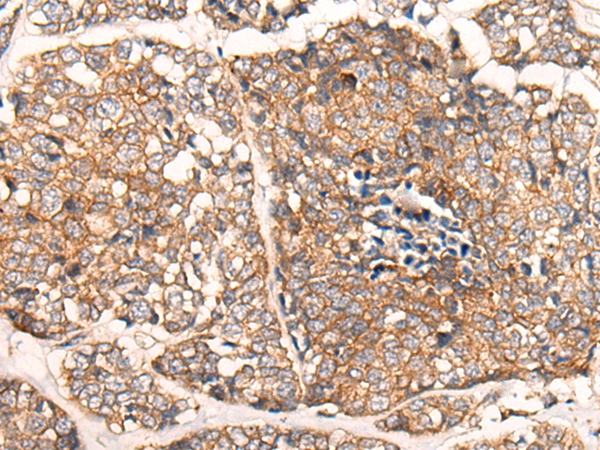Product Detail
Product NameCACNA2D2 Antibody
Host SpeciesRabbit
ClonalityPolyclonal
PurificationAntigen affinity purification
ApplicationsIHC
Species ReactivityHu Ms Rt
SpecificityThe antibody detects endogenous levels of total CACNA2D2 protein.
Immunogen Typepeptide
Immunogen DescSynthetic peptide corresponding to internal residues of human CACNA2D2
Target NameCACNA2D2
ConjugateUnconjugated
Other NamesCACNA2D
Accession NoSwiss-Prot:Q9NY47
NCBI Gene ID:9254
NCBI Protein:NP_001167522
Uniprot
Q9NY47
Gene ID
9254;
Concentration1.1mg/ml
FormulationRabbit IgG in pH7.4 PBS, 0.05% NaN3, 40% Glycerol.
StorageStore at -20˚C
Application Details
Immunohistochemistry: 1: 30-150
The image on the left is immunohistochemistry of paraffin-embedded Human esophagus cancer tissue using 46384(CACNA2D2 Antibody) at dilution 1/45, on the right is treated with synthetic peptide. (Original magnification: x200)
Calcium channels mediate the entry of calcium ions into the cell upon membrane polarization. This gene encodes the alpha-2/delta subunit of the voltage-dependent calcium channel complex. The complex consists of the main channel-forming subunit alpha-1, and auxiliary subunits alpha-2/delta, beta, and gamma. The auxiliary subunits function in the assembly and membrane localization of the complex, and modulate calcium currents and channel activation/inactivation kinetics. The subunit encoded by this gene undergoes post-translational cleavage to yield the extracellular alpha2 peptide and a membrane-anchored delta polypeptide. This subunit is a receptor for the antiepileptic drug, gabapentin. Mutations in this gene are associated with early infantile epileptic encephalopathy. Single nucleotide polymorphisms in this gene are correlated with increased sensitivity to opioid drugs. Alternative splicing results in multiple transcript variants encoding different isoforms.?
If you have published an article using product 46384, please notify us so that we can cite your literature.
et al,Exploring diverse programmed cell-death patterns to develop a novel gene signature for predicting the prognosis of lung adenocarcinoma patients
, (2024),
PMID:



 The lead time is currently 1 week.
The lead time is currently 1 week.



